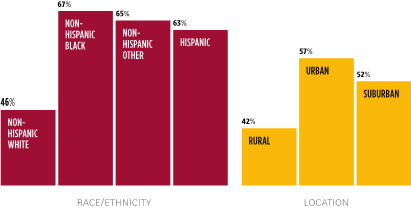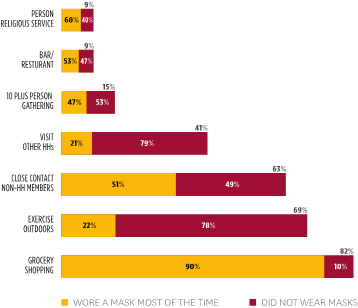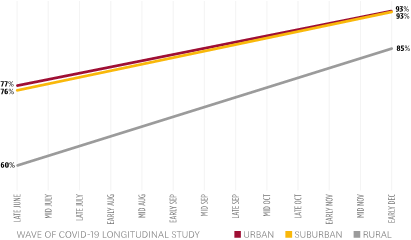While most U.S. adults—about 9 in 10—report wearing masks to protect against COVID-19, they wear masks inconsistently, raising concerns about how effectively they are protecting themselves and others, according to findings from the Understanding Coronavirus in America Tracking Survey conducted by the USC Dornsife Center for Economic and Social Research. Generally, people report much higher levels of mask use when engaging in essential activities like grocery shopping and seeking medical care—perhaps, because they must. In contrast, people report much lower levels of mask use during social interactions, such as visiting other people’s homes, having visitors over, or going to a bar or club. For example, in early December 2020, the survey found that only about half of U.S. adults wore a mask always or most of the time when coming in close contact—6 feet or nearer—with people outside their immediate households. The findings indicate that many people lack a clear understanding of optimal mask use and the risks posed by close contact with friends and family outside their immediate households. Policymakers should redouble efforts to send consistent messages to people not only about the overall importance of wearing masks to stop the virus’s spread but also about where, when and how to effectively wear masks.
Why Masks Matter
As of mid-January 2021, with infection and death rates soaring across the country, 400,000 U.S. residents had died from COVID-19. Unless people do more to stop the coronavirus’s spread, U.S. deaths are expected to reach almost 575,000 by March 2021. The simplest and most effective protection against the airborne virus is to correctly and consistently wear a face mask when coming in close contact with anyone outside your immediate household. By one estimate, if 95% of U.S. residents wore masks consistently, almost 60,000 fewer people in the United States would die from COVID-19 between now and April 2021. Along with social distancing, the Centers for Disease Control and Prevention (CDC) recommends that all people aged 2 and older wear masks in public settings and when around people who don’t live in their household.
Most Americans View Masks as Protective
Overall, since late March 2020, between 80% and 90% of U.S. adults consistently have viewed wearing a mask or face covering as an effective way to stay safe from the coronavirus, according to the Understanding Coronavirus in America Tracking Survey, an ongoing nationally representative internet-based panel survey of more than 6,000 people aged 18 and older (see Data Source).
Similarly, about 90% reported wearing a mask in the previous seven days to keep safe from the virus, although there are significant differences by locale, age, gender, race, income, education, and other sociodemographic factors. Generally, people who live in rural areas, are younger, are male, are white, have lower incomes, and have less education are less likely to report wearing masks, the survey found (Figure 1).
FIGURE 1: Percent Who Wore Mask in Previous Seven Days, by Education, Income, and Age, December 2020

Mask Use Inconsistent and More Common in Essential – Not Social – Activities
Deeper analysis of survey results, however, shows that many people who report venturing outside their homes are not following CDC mask-wearing guidelines. For example, according to the survey, about half wear masks always or most of the time when coming in close contact with people outside their immediate households. Again, mask use varied by sociodemographic factors, with men, younger people, whites and those living in rural areas less likely to report wearing masks when around people outside their household (see Figure 2).
Along with being asked if they had close contact—6 feet or nearer—with non-household members in the prior week at any time, survey respondents were asked if they had gone to a friend, neighbor or relative’s house; shopped at a grocery store; attended a gathering of more than 10 people; exercised outside; or attended indoor religious services, among other activities. Those who engaged in each activity were asked how often they wore a face mask or covering: always, most of the time, sometimes, rarely or never. Figure 3 shows the proportion of survey respondents who said they had done various activities in the last seven days, as well as the proportion who wore a mask always or most of the time during each activity
Along with being asked if they had close contact—6 feet or nearer—with non-household members in the prior week at any time, survey respondents were asked if they had gone to a friend, neighbor or relative’s house; shopped at a grocery store; attended a gathering of more than 10 people; exercised outside; or attended indoor religious services, among other activities. Those who engaged in each activity were asked how often they wore a face mask or covering: always, most of the time, sometimes, rarely or never. Figure 3 shows the proportion of survey respondents who said they had done various activities in the last seven days, as well as the proportion who wore a mask always or most of the time during each activity.
FIGURE 2: Percent Who Wore Mask Most of Time When in Close Contact with Non-Household Members by Race, Ethnicity, and Locale

FIGURE 3: Frequency of Activities and Mask Wearing by Activity

Grocery shopping was the most common activity reported, and the activity most likely to prompt mask use, with 90% reporting in early December they wore a mask always or most of the time while shopping. About two-thirds went outside for exercise, but only about 1 in 4 wore a mask while doing so. Other activities were less common but potentially riskier since indoor activities, singing, and drinking alcohol can make social distancing more challenging and increase the risk of spreading the virus. Levels of more risky activity have decreased since summer. In early December, about 4 in 10 people reported visiting someone else’s home, while smaller proportions attended a gathering of more than 10 people (14%), went to indoor religious services (9%), or went to a bar, club, or another gathering place (8%). In each of these situations, except for religious services, roughly half of those engaging in the activity wore a mask always or most of the time. Almost 60% reported wearing a mask when attending indoor religious services.
Wearing a mask while grocery shopping has increased strikingly over time as more grocery stores and other retailers, as well as local and state governments, mandated that shoppers wear masks. Overall, the percentage of grocery shoppers who wore a mask all or most of the time increased 17 percentage points— from 73% to 90% —from June to December. As shown in Figure 4, the greatest increase in mask wearing was among rural grocery shoppers who were 25 percentage points more likely to wear a mask in December than in June, along with those in the suburbs who were 17 points more likely. However, 15% of rural grocery shoppers still were not routinely or ever wearing a mask in December compared to less than 1 in 10 urban and suburban shoppers.
Implications
Since the pandemic began in early 2020, national, state and local leaders have sent inconsistent and conflicting messages to Americans about the importance of wearing face masks to slow the spread of COVID-19. Despite the confusion and differing guidelines and requirements, most Americans believe wearing a mask is an effective way to keep safe from the coronavirus. Moreover, people report much higher levels of mask use when engaging in essential activities like grocery shopping and seeking medical care—perhaps, because they must. In contrast, people are much less likely to wear masks during social interactions, such as visiting other people’s homes, having visitors over, or going to a bar.
FIGURE 4: Trends in Percent Who Wore Mask Most of Time While Grocery Shopping

These findings indicate that many people lack a clear understanding of when to wear masks and the risks posed by friends and family outside their immediate households. Policymakers should redouble efforts to send consistent messages to Americans not only about the importance of wearing masks to stop the virus’s spread but also about where, when and how to effectively wear masks. Additionally, public health officials should consider focusing educational efforts on people living in rural areas, younger people, men, white people, those with lower incomes, and people with less education—who all report being less likely to wear masks.
Data Source: This Data Brief is based on responses to the Under- standing Coronavirus in America Tracking Survey. Respondents are members of The Understanding America Study (UAS), an internet panel conducted by the Dornsife Center for Economic and Social Research (CESR) at the University of Southern California. The UAS is a probability-based online panel that is nationally repre- sentative of U.S. adults aged 18 and older. More than 6000 members of the UAS answer tracking survey questions every two weeks.
The overall margin of sampling error for the entire sample of U.S. adults is +/-1 percentage point. Margins of sampling error may be higher for some reported subgroups; these are provided in the study’s topline and crosstab reports. This brief references 18 waves of tracking survey data collected between March 10 and December 23, 2020. Graphs from the tracking survey are updated daily online at covid19pulse.usc.edu.
For more information on how the survey was conducted, as well as questionnaires, data files, and topline and crosstab reports, visit the CESR COVID Survey pages at uasdata.usc.edu.


You must be logged in to post a comment.